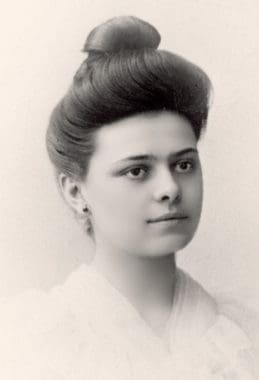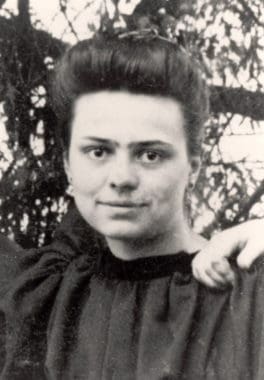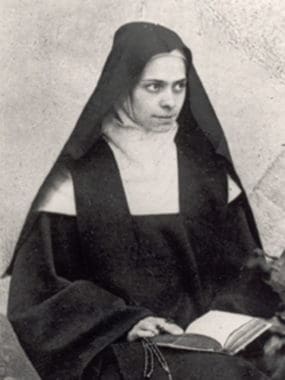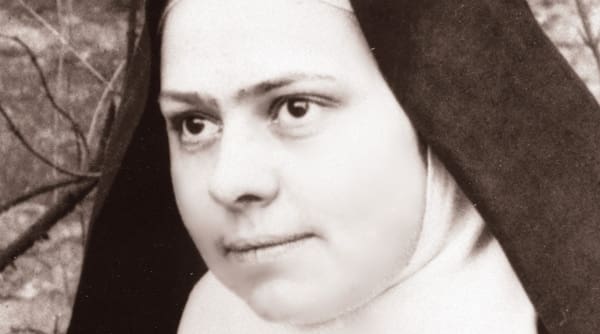Who is Elisabeth of the Trinity – Our Newest Saint?

Elisabeth of the Trinity was a Carmelite nun who died at the beginning of the 20th century at the age of 26. Born in an Army camp in 1880, the oldest of two sisters, her father was a veteran and POW of the Franco-Prussian War who died while she was still a child. Her mother had a conversion experience before her marriage and was zealous to live a pious life — and perhaps a little too fearful and scrupulous. Yet she was very loving and extremely devoted to her daughters. She moved the family to Dijon a few blocks from the parish church of Saint-Michel, and just across the street from the Carmelite Monastery Elisabeth would someday join. Josephine Catez raised her children around piano lessons, homeschool and involvement in the parish. It was in this context that Elisabeth discovered her devotion to Christ and learned how to control herself. She, in fact, had a fiery temper but learned through prayer how to submit this to God with love.

Her devotion to Christ and to mental prayer impressed her friends and the nuns of her community even before she entered. As a teenager, she self-identified with Teresa of Avila’s descriptions of the prayer of union. She was also among the first to read an early version of Thérèse of Lisieux’s Story of a Soul. After reading this work, she resolved to be a Carmelite nun. She came to see herself as the Bride of Christ, as the beloved of the Canticle of Canticles who cries out “Nescivi! I no longer know anything but conformity to Christ crucified.”
This devotion to Christ, rather than causing her to be indifferent to others, moved her to implicate herself in the faith life and everyday struggles of her friends and family. As her death grew closer, the more lovingly aware she became of their need for a deeper encounter with the Lord. She promised that it would increase her joy in heaven if her friends asked for her help and she was convinced that her mission was to help souls grow into a transforming union with God. In particular, she believed that she would be instrumental in leading souls out of self-occupation and into a beautiful silence where they might encounter the Lord and surrender themselves to Him completely.

Through confidence in the love of God and complete abandonment to His will, the transformation that she envisioned leads to adoration and praise. She described a simple movement of love in response to the pure excess of Divine Love that awaits us. This love suffers, but is, in Christ, unvanquished. The victory of love realized in Christ allows us to know the glory of God and the joy of praising Him. In her thought, God has predestined us in Christ to be the praise of His glory. She, in fact, believed that the name that God gave her from heaven to be “Laudem Gloriae” unto the praise of glory. At the same time, she made it her mission to make sure that everyone else realized this great vocation as well — in the particular way that God Himself had called them.
 The first step towards this, she proposed, is to occupy oneself with the love of the Holy Trinity – to recognize and to ponder the Father, Son and Holy Spirit as a bosom of eternal love and at the same time, our true home, the place where we are meant to dwell. Such an awareness of a personal relationship with the Trinity requires mindfulness of the purpose for which we are made. For her, we are created to welcome the excessive love of God and allow Him to satiate His desire to love us. The reality of heaven is not something that she believed was simply in the future of Christian existence – but present already in this present moment in time. God’s love comes to us in ever new ways through Christ Jesus, the Word of the Father, whom the Father continually sends into our hearts with the Fire of the Holy Spirit in ever new ways. With this dynamic view of the Trinity in each moment of life, she believed everything was a sacrament that gave us God and that time itself was “eternity begun and still in progress.”
The first step towards this, she proposed, is to occupy oneself with the love of the Holy Trinity – to recognize and to ponder the Father, Son and Holy Spirit as a bosom of eternal love and at the same time, our true home, the place where we are meant to dwell. Such an awareness of a personal relationship with the Trinity requires mindfulness of the purpose for which we are made. For her, we are created to welcome the excessive love of God and allow Him to satiate His desire to love us. The reality of heaven is not something that she believed was simply in the future of Christian existence – but present already in this present moment in time. God’s love comes to us in ever new ways through Christ Jesus, the Word of the Father, whom the Father continually sends into our hearts with the Fire of the Holy Spirit in ever new ways. With this dynamic view of the Trinity in each moment of life, she believed everything was a sacrament that gave us God and that time itself was “eternity begun and still in progress.”
National Celebration of Elizabeth of the Trinity’s Canonization
We are excited to announce that on, Sunday, November 6th, 2016, the Avila Foundation will be co-hosting the National Celebration of the Canonization of Elisabeth of the Trinity.
Please click below to support or join us for this celebration of the making of a saint!
Click HERE for more information or to register.
+
Editor’s Notes:
 In our noisy culture, Elizabeth of the Trinity reminds us of God’s power to establish in us a profound and peaceful stillness. She reminds us that that the Trinity is our home, and that God has created us in order to be united to Christ. In these pages, Sister Giovanna della Croce presents a brief and readable introduction to the teachings of Elizabeth of the Trinity, showing us the true path to contemplative prayer.
In our noisy culture, Elizabeth of the Trinity reminds us of God’s power to establish in us a profound and peaceful stillness. She reminds us that that the Trinity is our home, and that God has created us in order to be united to Christ. In these pages, Sister Giovanna della Croce presents a brief and readable introduction to the teachings of Elizabeth of the Trinity, showing us the true path to contemplative prayer.
Learn more about Saint Elizabeth of the Trinity and the life of a Praise of Glory, please click here for information on Sister Giovanna della Croce’s book Elizabeth of the Trinity: A Life of Praise to God, published in September 2016 by Sophia Institute Press and translated by Julie Enzler, Professor at the Avila Institute. The book is available for purchase at the link as well.
To “make a retreat” with Saint Elizabeth of the Trinity, please click here to visit www.discerninghearts.com for Dr. Anthony Lilles’ beautiful explanations of her retreat Heaven in Faith.
+
Art for this post on Elisabeth of the Trinity: Our New Saint: Photography of our newest saint: partial restoration of Portrait Elisabeth of the Trinity at the age of 20; Elisabeth of the Trinity on the day she entered the novitiate, August 2, 1901; Elisabeth of the Trinity wearing religious veil; Face Portrait of Elisabeth of the Trinity; all Willuconquer own work, January 2011, CCO 1.0 Universal Public Domain, Wikimedia Commons.





